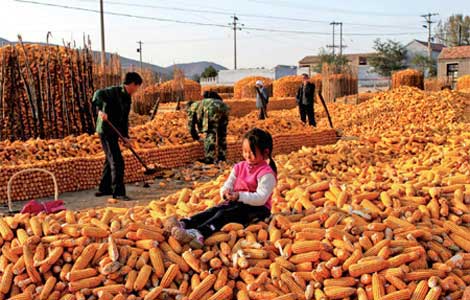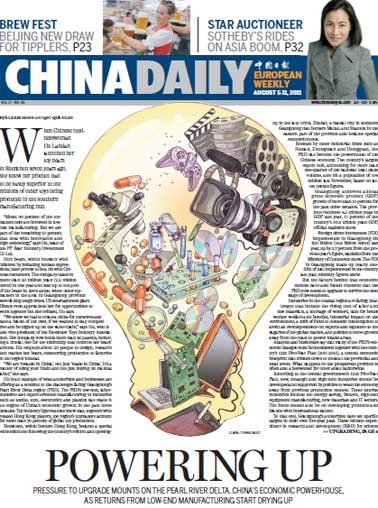Op-Ed Contributors
Robots may be employer-friendly but ...
Updated: 2011-08-12 08:05
By Amitendu Palit (China Daily)
Robots are not new to industrial manufacturing. They have been in use since the 1960s. Industrial economies such as the United States, the United Kingdom, Germany and Japan are the earliest and major users of robots. In more recent years, the use of industrial robots has increased in the Asia-Pacific region, particularly in South Korea, China, Australia, Thailand and India. Industrial robots are most widely used in automobile assembling and the electronics industries.
Though installation of robots in technologically advanced, high-income, and most importantly labor-scarce economies, may not raise eyebrows, it would do so in labor-surplus economies. It is therefore not surprising that Foxconn's decision to introduce 1 million robots in its production value chain by 2013 has created a flutter.
Foxconn - one of the largest private enterprises in China - known for designing electronic items for Apple and other leading global brands, is introducing robots to shift workers to more innovative and higher ends of the value chain. The robots that will be introduced over the next couple of years will replace humans in more mechanical functions.
Robots have quietly begun occupying space in production systems of developing and emerging market economies such as China, India and Thailand. According to statistics compiled by the International Federation of Robotics (IFR), Asia (including Australia) had 49 percent of the operational stock of multipurpose robots in the world in 2010. Europe and America had 33 percent and 17 percent, and Africa 1 percent. Japan has 62.6 percent of the industrial robots in Asia and 30.7 percent of such robots in the world. China has 9 percent of Asia's industrial robots, while South Korea has 17.3 percent. And Thailand and India have 1.6 percent and 1.0 percent of Asia's industrial robots.
Why are robots being encouraged in production? There is no denying that they are more "obedient" than humans and can perform in a more coordinated and programmed way. And robots are less demanding than humans. Employers do not have to worry about increasing their wages or social security. They can also be replaced more easily from the workforce if found performing at sub-optimal efficiency levels. In other words, they are simpler to manage as factors of production than human beings.
From a producer's perspective, though industrial robots perform several functions that workers do, they are not "labor" and are recognized as capital or technology-intensive inputs in production. In this respect, introduction of robots for replacing workers by Foxconn and other employers results in industrial production becoming more capital-intensive. Robots would be considered labor-displacing instruments with effects similar to those seen during the Industrial Revolution when machines displaced men.
A change in factor-mix involving greater capital and technology at the expense of workers is useful for producers as long as it reduces costs, increases efficiency and enlarges surplus. From another perspective though, replacement of workers by robots is disturbing because it means fewer jobs and opportunities for human beings. For labor-surplus economies of Asia Pacific and Africa, this may mean confronting the historical dilemma between man and machine, with the latter again threatening to forcefully dislodge the former.
Some human functions are difficult to be replaced by robots. These are high-value skill-intensive jobs where application of thoughts and ideas are critical and the importance of innovation and creativity is high. As of now, robots do not threaten humans in these spheres. But this may not be good enough to assuage workers in China and India, where cheap labor has been a source of global competitiveness in several industries.
A huge percentage of the workforce in China, India and other developing economies and emerging markets is semi-skilled and capable of performing only basic manual functions. Industrial robots are distinct threats for these workers, particularly because substitution of humans by robots is not on a one-to-one principle. An industrial multi-purpose robot can perform several tasks in greater volumes and would therefore replace more than one human worker.
Robot density - number of robots in an industry per 10,000 workers - is still low in most Asian countries, except Japan. Given the increasing installation of robots in more labor-intensive consumer industries like rubber, plastics and food, the robot density in countries is expected to increase significantly in the future.
China may see a considerable increase in number of robots because of its expanding consumer markets. Enterprises in India, Brazil and Russia will focus more on robots, too, as workers' wages rise in these countries forcing industries to search for radical solutions to maintain competitiveness. Modern industrial development clearly accepts robots as a means of efficiency, notwithstanding the disturbances they might create elsewhere.
The author is a visiting senior research fellow at the Institute of South Asian Studies, National University of Singapore.
(China Daily 08/12/2011 page9)
E-paper

My Chinese Valentine
Local businesses are cashing in on a traditional love story involving a cow herder and a goddess
Outdoor success
Lifting the veil
Allure of mystery
Specials

Star journalist leaves legacy
Li Xing, China Daily's assistant editor-in-chief and veteran columnist, died of a cerebral hemorrhage on Aug 7 in Washington DC, US.

Sowing the seeds of doubt
The presence in China of multinationals such as Monsanto and Pioneer is sparking controversy

Lifting the veil
Beijing's Palace Museum, also known as the Forbidden City, is steeped in history, dreams and tears, which are perfectly reflected in design.
